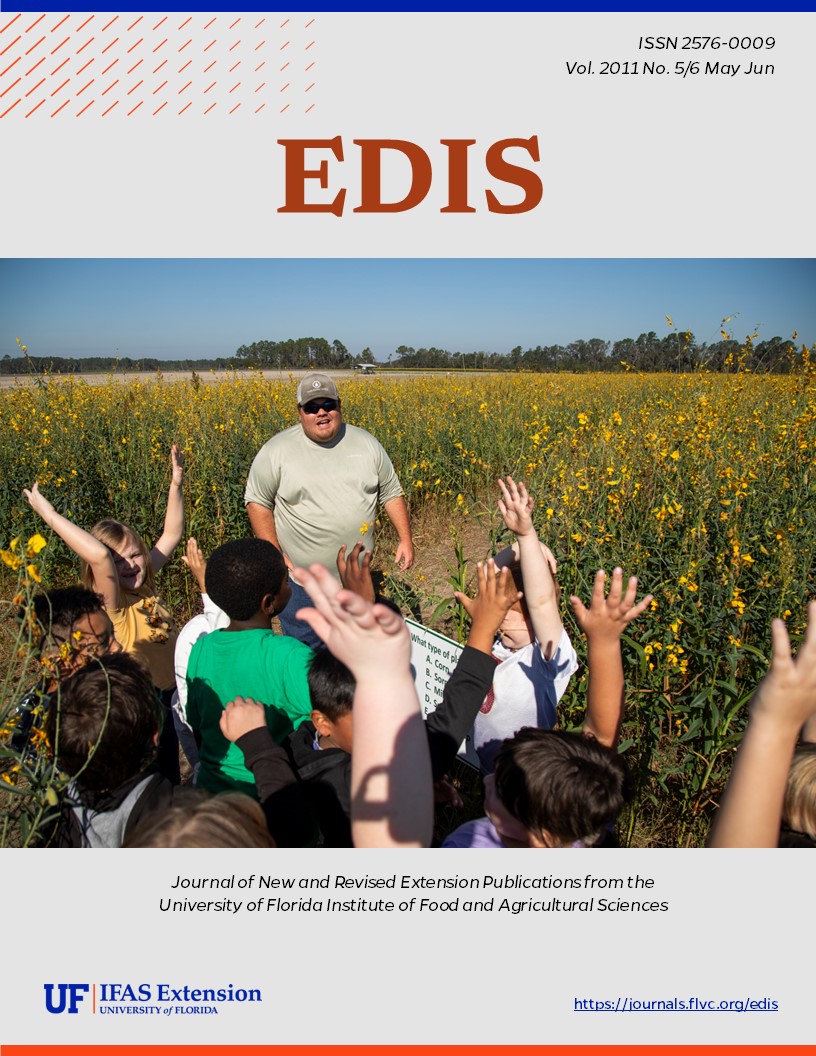Resumen
Ambrosia beetles are wood-degrading insects that live in nutritional symbiosis with ambrosia fungi. Usually we consider ambrosia beetles beneficial because they accelerate the decay of dead trees, which is important for nutrient cycling in healthy forests. However, the redbay ambrosia beetle and its fungal symbiont transmit the causal pathogen of laurel wilt disease among plants in the Laurel family (Lauraceae). They are considered a “very high risk” invasive disease pest complex having potential equal to that of Dutch elm disease or chestnut blight. Laurel wilt is a relatively new disease, and much is still unknown about how it will impact the flora of North America. This revised 7-page fact sheet highlights what we do know about this important new pest. Written by Rajinder Mann, Jiri Hulcr, Jorge Peña, and Lukasz Stelinski and published by the UF Department of Entomology and Nematology, May 2011.
Citas
Alabama Forestry Commission. (November 2010). Redbay ambrosia beetle. http://www.forestry.state.al.us/RedbayAmbrosiaBeetle.aspx (18 April 2011).
Cameron, RS, Bates C, Johnson J. (September 2008). Distribution and spread of laurel wilt disease in Georgia: 2006-08 survey and fi eld observations. Georgia Forestry Commission. U.S. Forest Service. http://fhm.fs.fed.us/em/funded/09/so-em-08-02-report.pdf (18 April 2011).
Crane JH. (March 2009). Issues concerning the control of the redbay ambrosia beetle (Xyleborus glabratus) and spread of the laurel wilt pathogen (Raffaelea lauricola). Avocadosource.com. http://www.avocadosource.com/papers/Research_Articles/CraneJonathan2009.pdf (18 April 2011).
Crane JH, Peña JE, Osborne JL. (December 2008). Redbay ambrosia beetle-laurel wilt pathogen: a potential major problem for the Florida avocado industry. EDIS. http://edis.ifas.ufl.edu/hs379 (18 April 2011). https://doi.org/10.32473/edis-hs379-2008
Crane JH, Peña JE, Ploetz RC, Palmateer AJ. (2011). Proposed grove strategies. FDACS-Division of Plant Industry. http://www.freshfromflorida.com/pi/enpp/pathology/images/proposed-grove-strategies.pdf (18 April 2011).
Florida Exotic Pest Plant Council. (February 2011). Florida EPPC's 2009 Invasive Plant Species List. http://www.fleppc.org/list/09list.htm (18 April 2011).
Fraedrich SW, Harrington TC, Rabaglia RJ. (2007). Laurel wilt: a new and devastating disease of redbay caused by a fungal symbiont of the exotic redbay ambrosia beetle. Newsletter of the Michigan Entomological Society 52: 15-16.
Fraedrich SW, Harrington TC, Rabaglia RJ, Mayfield AE, Hanula JL, Eickwort JM, Miller DR. 2008. A fungal symbiont of the redbay ambrosia beetle causes a lethal wilt in redbay and other Lauraceae in the Southeastern United States. Plant Disease 92: 215-224. https://doi.org/10.1094/PDIS-92-2-0215
Global Invasive Species Database. (May 2010). Xyleborus glabratus (insect). http://www.issg.org/database/species/ecology.asp?si=1536&fr=1&sts=&lang=EN (18 April 2011).
Haack RA. 2003. Intercepted Scolytidae (Coleoptera) at U.S. ports of entry: 1985-2000. Integrated Pest Management Reviews 6: 253-282. https://doi.org/10.1023/A:1025715200538
Haack RA. 2006. Exotic bark- and wood-boring Coleoptera in the United States: recent establishments and interceptions. Canadian Journal of Forest Research 36: 269-288. https://doi.org/10.1139/x05-249
Hanula JL, Mayfield AE, Fraedrich SW, Rabaglia RJ. 2008. Biology and host associations of redbay ambrosia beetle (Coleoptera: Curculionidae: Scolytinae), exotic vector of laurel wilt killing redbay trees in the southeastern United States. Journal of Economic Entomology 101: 1276-1286. https://doi.org/10.1093/jee/101.4.1276
Hanula JL, Sullivan B. 2008. Manuka oil and phoebe oil are attractive baits for Xyleborus glabratus (Coleoptera: Scolytinae), the vector of laurel wilt. Environmental Entomology 37: 1403-1409. https://doi.org/10.1603/0046-225X-37.6.1403
Kirkendall LR. 1983. The evolution of mating systems in bark and ambrosia beetles (Coleoptera: Scolytidae and Platypodidae). Zoological Journal of the Linnean Society 77: 293-352. https://doi.org/10.1111/j.1096-3642.1983.tb00858.x
Koch FH, Smith WD. 2008. Spatio-temporal analysis of Xyleborus glabratus (Coleoptera: Circulionidae: Scolytinae) invasion in eastern US forests. Environmental Entomology 37: 442-452. https://doi.org/10.1093/ee/37.2.442
Mayfield AE, Thomas MC. (July 2009). The redbay ambrosia beetle, Xyleborus glabratus Eichhoff (Scolytinae: Curculionidae). FDACS-Division of Plant Industry. http://www.freshfromflorida.com/pi/enpp/ento/x.glabratus.html (18 April 2011).
Oliver JB, Mannion CM. 2001. Ambrosia beetle (Coleoptera: Scolytidae) species attacking chestnut and captured in ethanol-baited traps in middle Tennessee. Environmental Entomology 30: 909-918. https://doi.org/10.1603/0046-225X-30.5.909
Ploetz RC, Peña JE. (2007). Laurel wilt: a lethal disease on avocado and other Lauraceous hosts. Caribbeanseeds.com. http://www.caribbeanseeds.com/Laurel-wilt-overview.pdf (18 April 2011).
Rabaglia RJ, Dole SA, Cognat AI. 2006. Review of American Xyleborina (Coleoptera : Curculionidae : Scolytinae) occurring North of Mexico, with an illustrated key. Annals of the Entomological Society of America 99: 1034-1056. https://doi.org/10.1603/0013-8746(2006)99[1034:ROAXCC]2.0.CO;2
Rabaglia R. (June 2008). Xyleborus glabratus. Exotic Forest Pest Information System for North America. http://spfnic.fs.fed.us/exfor/data/pestreports.cfm?pestidval=148&langdisplay=english (18 April 2011).
Riggins JJ, Smith JA, Mayfield AE, Layton B, Balbalian C, Campbell R. 2010. First occurrence of laurel wilt disease on redbay trees in Mississippi Plant Disease 94: 634. https://doi.org/10.1094/PDIS-94-5-0634C
Smith JA, Mount L, Mayfield AE, Bates CA, Lamborn WA, Fraedrich SW. 2009. First report of laurel wilt disease caused by Raffaelea lauricola on camphor in Florida and Georgia. Plant Disease 93:198. https://doi.org/10.1094/PDIS-93-2-0198B
USDA Forest Service. (March 2011). Laurel wilt. http://www.fs.fed.us/r8/foresthealth/laurelwilt/index.shtml (18 April 2011).

